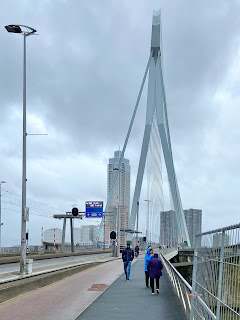Come with me on a tour of this National Park, one I had never visited, even though it is only a 40 minute drive from where a couple of my siblings live. Maybe you’ll be inspired to visit, should you pass this way some day. I was en route from the east, coming on the Yellowhead Highway, which is also north of their homes. This highway actually bisects the park, with Plains Bison in the northern section and Woodlands Bison in the south, which seems counter-intuitive.
It was a grey day in early May, with rain threatening. I checked things out on my iPhone at a rest stop east of the park - $7.75 for a Seniors Day Pass; that’s okay. I motored on and turned into the main park entrance, which is on the
north side. No one was at the gate, but instructions there directed me to buy my pass at a roadside ticket dispenser
farther on, which I did.
Then I drove on and into what appeared to be the guest centre. No one there, closed for training! Fortunately, there was
a pamphlet of the park with a map in a rack outside. I picked one up and began to follow the Elk Island Parkway route north.
Not much farther was the first promising looking location - the Bison Loop to the right. It did not disappoint.
There were a number of the beasts calmly gazing or resting in the grassy meadows among the trees to my right. I reasoned that with the size of those wild creatures, I was safer in the car. So, I took some photos through the passenger window with my phone but then dug out my old point-and-shoot camera, a Canon PowerShot A 2000 IS, which still does take clearer
photos and took some more.
1There were one or two cars ahead of me that I could see and a couple of vehicles followed me in.
Leaving this area I rejoined the parkway and continued north, driving past what the map seemed to identify as Mud Lake, with its beaver lodges.
Continuing north I then did take the first road, Oster Lake, to the west. I shortly came across a couple of bison on opposite sides of the road. The one to my right was a majestic bull specimen, resting in the ditch. Returning later, he was still there, now on my side of the road, so I got a great shot.
Otherwise, not much seemed to be happening when to got to the parking lot. There were a number of vehicles there but no one in sight. I assumed they were off exploring the trails, but I
was coming from a wedding anniversary party and not dressed for that. I returned to the parkway again and drove up to Astotin Lake.
The parking lot, separated from the lake by shrubs and trees, was almost full, but still no one else in sight. I stepped out of the car with my camera and began to make my way along the lake. I almost missed this bird, perched low right in front of me. However, I got in a couple of snaps before she - I think it was a female Harrier - calmly flew off.
I had spotted a number of birds about a boardwalk farther on so I made my way on a wide path over a hillock between
some spruces and other foliage and down to the walk. The birds making themselves most busy here were what I
 deemed to be a number of Lesser Yellowlegs. I had more often seen the Greater Variety on the shores of Lake Winnipeg as a child. These shorebirds had no beach or mud flat to peruse for delicacies here but seemed just as at home wading amongst or perching
deemed to be a number of Lesser Yellowlegs. I had more often seen the Greater Variety on the shores of Lake Winnipeg as a child. These shorebirds had no beach or mud flat to peruse for delicacies here but seemed just as at home wading amongst or perching looking for all the world as if they were having balancing problems on that log.
I spent some time on the boardwalk, joined at one point by one of the waders. I was about to turn back to the parking lot
With that, I made my way back to the car, joining throngs of mostly younger people coming from some buildings farther off to the left. Ah, teachers and students from those training sessions. Well, it was time for me to hit the road to my brother’s place east and south at Tofield. It had been a worthwhile stop.

















.jpeg)


